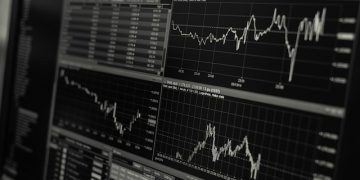Stocks on Wall Street completed their greatest week because February, with the excellent S&P 500 index closing at a record high, after a surge in US inflation disappointed the marketplace’s worst-case forecasts.
The S&P 500 obtained 1 percent on Friday, as well as had an once a week rise of 3.8 per cent, eclipsing a previous record close just over 3 weeks earlier.
The innovation focused Nasdaq Composite climbed 0.7 per cent, bringing its weekly rise to 3.6 percent.
The US labour division stated on Friday that customer rates climbed up 6.8 per cent in November from the very same month in 2020, matching economic experts’ forecasts and the highest possible boost in 39 years.
In spite of the increase, the figures were something of a relief for investors that had actually girded themselves for information that can have revealed a 7 percent or bigger surge.
Capitalists and also experts said the reading would certainly keep the Federal Book on its current program, aiding buoy markets that had been worried that a greater inflation number would certainly force the Fed to tighten up monetary plan faster, harming stocks.
” The market was anticipating this inflation analysis and high inflation has actually been priced into markets for several months currently,” said George Ball, chair of investment team Sanders Morris Harris.
Numerous investors additionally expect price boosts to come to a head quickly, as supply chain problems– triggered by coronavirus closures as well as a rebound in energy markets from the midsts of 2020’s economic slowdown– simplicity.
November’s inflation record revealed fuel rates increased 3.5 per cent over the month, below 4.8 percent in between September and also October. The month-to-month price of price gains for made use of cars as well as housing was steady.
” The bond market is informing us inflation is not going to lack control for long,” said Guillaume Paillat, multi-asset portfolio supervisor at Aviva Investors.
The yield on the benchmark 10-year Treasury note bordered down 0.01 percentage point to 1.49 percent. The five-year, five-year inflation swap price, a step of longer-term expectations of price rises, inched reduced to 2.15 percent.
The yield on the two-year United States Treasury note, which moves inversely to the cost of the government debt instrument and also tracks monetary policy expectations, dipped 0.03 portion points to 0.66 percent.
Jay Powell, Fed chair, has actually provided a strong signal that the US reserve bank, which holds its following monetary policy meeting following week, might quickly relax its $120bn-a-month of bond purchases that have decreased loaning costs as well as increased stock exchange belief through the pandemic period.
This could be completed by March, in a forerunner to the Fed elevating interest rates from their present record low, leading financial experts evaluated for the Financial Times have actually claimed.
” If the Fed does not pull back several of its support now as well as begin to normalise monetary plan, they’ll have really little ammo when we do get into the following recession,” said Paul Jackson, head of asset allowance research study at fund supervisor Invesco.
” However I suspect US inflation is just about peaking out currently.”
In Europe, the local Stoxx 600 share index shut 0.3 percent reduced. The UK’s FTSE 100 scale folded 0.4 percent.
Hong Kong’s Hang Seng index dropped 1.1 percent. The Nikkei 225 in Tokyo shut 1 percent lower.
In currencies, the dollar index, which tracks the performance of the greenback against six others, was down 0.2 per cent.
These 6 miscalculated stocks are making the S&P 500 look more costly than it truly is
It’s impossible to know which stocks will certainly dominate the securities market in a years’s time, however we can fairly with confidence say which business will not be on that list: stocks that currently cover today’s market-cap ranking– namely Apple AAPL, +2.80%, Microsoft NASDAQ: MSFT +2.83% , Amazon.com AMZN -1.12%, Alphabet (Google) GOOG, +0.38% as well as Meta Platforms (Facebook) FB, -0.02%.
That’s due to the fact that it’s uncommon for stocks on top of the market-cap position to maintain their standing a decade later on. Not only do they usually fall out of the leading 10, they additionally underperform the marketplace on average over the decade.
That’s according to an evaluation carried out by Study Affiliates, the investment company headed by Robert Arnott. To show the ragged edge of the marketplace’s “top dogs,” he computed what happened over the decade of the 1980s to the 10 largest openly traded companies at the start of that 10-year duration. Eight of the 10 were not on 1990’s top-10 listing, and all 10 on 1980’s listing underperformed the globe securities market over the succeeding years.
Arnott found that the 1980s were not special. He reached a comparable outcome for the top stocks of the 1990s, 2000s, and also 2010s. Typically, a stock on any of these lists underperformed the marketplace over the succeeding decade. Furthermore, there was in between a 70% and also 80% possibility that any kind of given stock would not get on the comparable list one decade for this reason.
Arnott highlighted these top firms’ underperformance in an additional method also: He created a hypothetical profile that each year had the globe’s 10-largest companies. The performance of this profile is plotted in the graph below. Over the 40 years from completion of 1980 through the end of 2020, this portfolio lagged a buy-and-hold by 1.8 annualized portion factors.
Numerous financial investment lessons can be drawn from Arnott’s interesting results. One is that cap-weighting is not the ideal weighting system for your profile. Equal-weighting is one evident alternative, and it has actually defeated cap-weighting: given that 1971, according to data from S&P Dow Jones Indices, the equal-weighted variation of the S&P 500 SPX, +0.95% has outmatched the cap-weighted version by 1.5 annualized portion factors.
Valuing a cap-weighted market.
Arnott thinks there are also far better ways of weighting stocks in an index past equal weighting. His firm maintains a number of so-called essential indices that base a stock’s weight on fundamental features such as sales, capital, dividends as well as publication equity worth.
Simply 6 stocks– Apple, Microsoft, Alphabet, Amazon, Tesla and Meta Operatings systems– account for 26% of the S&P 500’s complete market cap.
However there’s another financial investment effects of Arnott’s data that I wish to concentrate on: His results highlight the difficulties identifying the assessment of a lopsided market.
Think about the S&P 500 currently, in which just 6 stocks– Apple, Microsoft, Alphabet, Amazon, Tesla TSLA, +1.32% and Meta Systems– represent 26% of the index’s total market cap. Envision a circumstance in which those 6 are overvalued while the various other 494 stocks, on equilibrium, are extra relatively valued. In that instance, the valuation proportions for the S&P 500 overall could paint a manipulated picture.
This scenario isn’t just hypothetical. The largest six stocks currently have an ordinary price/earnings ratio of 62.0, according to FactSet, greater than double the ordinary across all stocks in the S&P 500 of 29.1 and also almost triple its average P/E proportion of 21.4.



